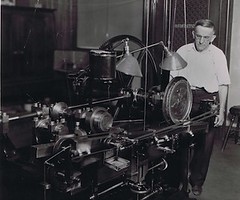Adam Pietz artwork, photographs, and rubbings, 1932 - 1952
Creator
- Name
- Pietz, Adam, 1873-1961
- Abstract
- Adam Pietz (1873-1961) was a sculptor, medalist engraver, and etcher.
Administrative Information
Access
Collection open to all researchers.
Preferred Citation
Adam Pietz artwork, photographs, and rubbings, 1932-1952, Archives, American Numismatic Society.
Restrictions
Copyright restrictions may apply. Permission to publish or reproduce must be secured from the American Numismatic Society.
Biographical Note
Adam Pietz (1873-1961) was a sculptor, medalist engraver, and etcher. He was born in Offenbach, Germany, and moved to the U.S. in 1889 where he studied at the Chicago Art Institute (1892-1893), Drexel Institute (1894-1898), and the Pennsylvania Academy of the Fine Arts (1899-1903). By 1897 he was an established engraver and die sinker operating out of a private studio on Chestnut Street in Philadelphia. He also served as assistant chief engraver at the Philadelphia Mint from 1927 to 1946. In 1917 he designed a World War I good luck medal for the United States. This So-Called Dollar is remembered for having a swastika, an ancient good-luck symbol, on its obverse. He designed the American Numismatic Association’s Medal of Merit. His only coin design to be minted was the Iowa Statehood Centennial Commemorative Half Dollar (1946). After retiring, he continued his work on medals for the Treasury Department, producing designs that included the Meritorious Service Award Medal (1949), Alexander Hamilton Medal (reverse, 1955), and the Distinguished Service Award (bestowed after his death, 1963).
Scope and Content Note
Contains the following artwork by Pietz: four pencil sketches of an eagle and the reverse of a 1932 commemorative quarter dollar; a sketch of the design for the 1925 presidential inaugural medal; an undated sketch of an obverse and reverse of a medal for the Pennsylvania Railroad; a large watercolor of a proposed commemorative half dollar depicting Davy Crocket, James Bowie, and William Barrett Travis, probably for the Texas centennial of 1936; and a photographic print of a design for the tercentenary of the Pine Tree shilling in 1952. There are also assorted images likely used by Pietz in the development of his designs, such as rubbings of mostly German medals, photographs of ancient and modern coins and medals, and photographs of proposed designs for the obverse and reverse of the 1932 George Washington quarter and the 1938 Thomas Jefferson nickel. Also includes a photograph of Pietz overseeing a transfer engraving machine at the United States Mint, Philadelphia, and an empty envelope from the Iowa Centennial Committee.
Related Entities
Genre/Format
Person
